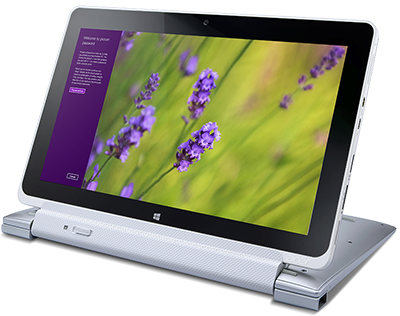
Microsoft’s decision to offer tablets in two flavors–Intel-powered slates running full windows 8 and ARM-powered units running Windows RT–has created a marketing and branding problem for manufacturers: How these very different products going to be distinguished for buyers?
One solution that seems to be gaining popularity is to call the Intel/full Windows versions “tablet PCs.” This seems to assume, probably correctly, that customers have little memory of the ungainly and, outside of some niche markets, unpopular, touchscreen laptops and slates that went by that name starting in 2003, and that they are willing to give the name, and the category, a fresh look with Windows 8.
Acer today announced its latest entrant, the Iconia W510 Tablet PC, a 10.1″ , 1.3-lb.slate powered by an Intel Atom Z2760 (Clover Trail) processor. The W510 will start at $499 for a 16 gigabyte version and $599 for 64 GB. A keyboard and battery dock that turns the tablet into a sort of notebook adds $250 and doubles the weight to 2.6 lb.
Hewlett-Packard is also using the tablet PC moniker, though it applies it to a broader ranger of products. On its small business website, the Slate 2, an 8.9″, $849 pure tablet currently shipping with Windows 7 is called a Tablet PC. But so is the EliteBook 2760p, a more traditional 12.1″ touchscreen convertible (meaning the screen can rotate and flip over to form a bulky slate) notebook. It runs an Intel Core i3, i5, or i7 processor, weighs 4 lb., and starts at $1,479.
Dell calls its current 10.1″, $679 Latitude ST Windows 7 tablet a Tablet PC. It also uses the name for a the Latitude XT3, a design similar to the HP EliteBook but even heftier with a 13.3″ display. Dell’s web site does not make clear whether it will use the Tablet PC names for its upcoming XPS 10 pure Windows 8 tablet or the XPS Duo 12, a sort of old-fashioned Tablet PC with a novel screen that can rotate vertically.
Lenovo, interestingly, calls the ThinkPad X230, the latest version of a conventional Tablet PC that has been in its product line for several years, just a “convertible tablet.” Like Acer, Lenovo is also shipping Android tablets in addition to planning for the windows versions.
Microsoft, meanwhile, seems to believe its customers will know what its tablets are when they see them. It plans both Windows 8 and Windows RT versions of the Surface, which will come with a very thin membrane keyboard that doubles as a cover. But Microsoft is staying out of the naming game. Its web site avoids calling them either tablets or slates, let alone Tablet PCs. They are just Surface.
